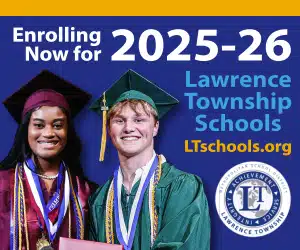Tee off the summer at the Indianapolis Museum of Art’s new, artist-designed putt-putt course.
Following a tremendously successful first summer, Mini Golf at the IMA is back. The course, located on the IMA’s Alliance Sculpture Court, features brand new holes designed by local and regional artists, along with some familiar favorites. Each hole is inspired by the natural world, as seen across the IMA campus in the gardens, The Virginia B. Fairbanks Art & Nature Park: 100 Acres, galleries and in exhibitions such as Audubon: Drawn to Nature.
Guests will putt through the plains of Africa, discover the king of the jungle, escape a molten carpet of hot lava, float past gleaming glaciers, travel downstream on the White River and weave through cattails and rocks in Indiana wetlands.
The course will be open to the public May 28 through Sept. 3 during regular museum hours, including Thursday evenings until 9 p.m. The course is included with general admission, and IMA members get exclusive access and can play for free all summer long. During free admission times, public tickets will be available for a reduced fee of $8, while IMA members play for free. Exclusive member preview days will be offered May 26 and 27 during regular Museum hours. Snacks and refreshments will be available for purchase on this one-of-a-kind course.
Come enjoy a sunny afternoon with friends or bring the whole family along to explore Mini Golf at the IMA this summer.
Lead support for Mini Golf at the IMA is provided by Barnes & Thornburg, LLP. Additional support is provided by Sun King Brewery and the Volunteers of the IMA. This program is part of the IMA’s ARTx series, made possible by a gift from the Efroymson Family Fund.
Mini Golf at the IMA Holes include:
Stroll Gardens puts the mini in mini golf. Sculptor Kevin Bielicki draws inspiration from Japanese gardens, a style known for meticulous design and illusions of scale. Enjoy a moment of Zen while encountering soft hills, pale stones and a traditional pagoda. Bielicki is also currently working on an outdoor sculpture commission at Spades Park for Reconnecting to Our Waterways (ROW), a local community initiative.
The Carpet is Hot Lava recreates a vivid childhood memory for artist Martin Kuntz: jumping across his parents’ living room furniture to avoid touching the ground. The hole features a giant triceratops submerged in lava from a nearby volcanic eruption. Conquer this hole by carefully navigating the dangers and doom of pink lava. Kuntz was born in the Netherlands, but spent his childhood avoiding the “carpet lava” on the south side of Indianapolis. When he’s not designing mini golf holes, he is a large scale Pop painter working primarily in oil and acrylic.
2058: the first mini golf hole without ice takes you on a journey to the future where glaciers have melted due to drastic climate change. Avoid the arctic icebergs that block the hole. This frosty field is the work of Crawley + Owens, an artistic duo made up of Luke Crawley and local Harrison Center for the Arts artist Quincy Owens. Crawley is the proud father of two boys, while Owen has five children. These two dads hope to preserve our fragile planet for future generations.
WaterPLAY will prove to be dam challenging with its fiberglass cattails, fish-like obstacles, and uneven rocks that lead to a nest-like beaver lodge. The hole mimics an Indiana wetland with its wavelike pattern and varying shades of blue. Artist Veronica Vela is no stranger to the IMA. You can find her daily inside the Museum Store. She has teamed up with her husband Jason Wolfe who spends his days as a vice president at a local firm, Demerly Architects. These two have collaborated previously on furniture design, art installations, and their own home.

To Bee or Not to Bee celebrates nature’s greatest pollinator, the honey bee, and highlights the recent declines seen in bee populations around the world. The giant bee sitting atop this hole is something you’ll have to see to bee-lieve. Navigate through a beehive in order to find the honeycomb hole. Designed by mini-golf-gurus, Tom Loftus and Robin Schwartzman, a duo that has played and critiqued more than 125 courses in their blog, A Couple of Putts.
Putting Around Africa is a tiny tour of Africa. Graphic designer Scott Shoemaker, who works at the Indianapolis Zoo, brings animals like the yellow-billed hornbill and ring-tailed lemur to life. Don’t let the stalking cheetah take your golf ball, with a top sprinting speed of 60 miles per hour, retrieval is unlikely.
Cardinal 200 is a mashup of Indiana’s state bird, an Indy Car and crown made out of corn—all things quintessentially Hoosier. Pro tip: Bank your golf ball off the barn for the best shot at a hole-in-one. Artist William Denton Ray is a native Hoosier but his artwork has been collected throughout the United States and the world, including France, Australia and Canada.
Canyonlands pays homage to the rich red-orange sandstone that draw millions of visitors each year to Utah’s national parks. Pick your poison by traversing the narrow canyon ridge or take a chance in the river below. Artist Sam Welch is a Herron School of Art and Design grad who enjoys mountain biking, backpacking and kayaking.
Pond Life features a replica of Paramecium caudatum, a common single-cell organism found in fresh and salt water all over the Earth, including the pond at the Virginia B. Fairbanks Art & Nature Park: 100 Acres. Growing no bigger than a quarter of a millimeter, you would need 168 P. caudatum just to equal the length of a golf ball. At 10-feet long, this hole is the giant mastermind of married designers Beth Eby, an architect, and Chad Eby, a Herron professor, who are returning course artists.
15-1 was designed by artist Colin Nesbit. In colonial times, 15 percent of Indiana was covered in prairie grasses, but that number has since been reduced to just one percent. 15-1 features examples of the types of prairie grasses that are indigenous to our state. Through careful conservation, the remaining prairies are being protected to allow future generations of Hoosiers to admire and understand this unique ecosystem.
Stumped was created by the youngest team of artists on the course, students from Noblesville High School’s Sculpture II class under the direction of teacher Craig Helming. Trees typically serve as a bane of existence for golfers. This hole aims to change that by fostering a new appreciation for trees and the wealth of natural wonders a fallen tree gives the forest.
Poplar Mechanics abstractly recreates the experience of walking through the forests of Brown County. The forest ramble is inspired by Indiana’s state tree, the Tulip Poplar, which gives the hole its clever name. Artist Gautam Rao is a professor at neighboring Butler University and has exhibited his work recently in Indy, Chicago and New York.
A Forest of Sound invites you to hit all the right notes through this celebration of natural noise. A high school math and science teacher by day, artist Luke Crawley recreates some of humankind’s earliest attempts at making music in this sonically amusing hole. Sources for inspiration include early percussion instruments, fashioned from logs, which recreated the melodious sounds of falling rain.
Jungle PARadise is another William Denton Ray creation. You’ll find yourself face-to-face with a geometric giraffe, a slithery snake, an enormous elephant, a top-notch toucan and a mischievous monkey. While these creatures are nothing to sneeze at—be alert. The hole is carefully guarded by the king of the jungle himself, a larger-than-life lion.
Geology of Indiana draws its inspiration from the Indiana Geologic Record. Putt past a giant mastodon skull, the largest creature found on Indiana’s fossil record, dating back to the Ice Age. The sides of the hole feature a hand-drawn cutout depicting millennia in both bedrock geology and surface topography. Find the limestone cave, designed by Indy artist Brent Aldrich, and be destined for a hole-in-one.
Shadow-Tailed Scourge is the return of those cheeky squirrels who were a fan favorite last season. Created by Beth and Chad Eby, this hole commemorates the “Great Squirrel Invasion” of 1822 when a westward migration of squirrels decimated crops in Indiana. Navigate past the five giant squirrels to drive your opponent nuts.
White River Putt encourages hitting the water hazard. Returning artist Alan Goffinski created a replica of the White River and its tributaries which fan out over Indianapolis and run through vibrant and diverse neighborhoods. Goffinski is a central Virginia based artist who works with a variety of media including sound, light and sculpture.
Reflections in the Forest provides a respite from the summer sun thanks to carefully placed tree canopies. Inspired by acreage from her family farm, artist Suzy Slater creates a forest of towering trees on the green. The sun will make the branches glitter with light, which is reminiscent of her career before mini golf. Slater was a custom jewelry designer for more than a decade in Central Florida.
For more information on the course, group tour and rental opportunities, please visit http://www.imamuseum.org/minig
**Photos from 2016 years course.
About the Indianapolis Museum of Art
The Indianapolis Museum of Art (IMA) is located on a 152-acre campus of lush gardens, historic homes, outdoor sculptures, inspiring performance and gallery spaces. Founded in 1883, the IMA is among the 10 oldest and 10 largest encyclopedic art museums in the United States and features significant collections of African, American, Asian, European, contemporary art and design arts that span 5,000 years of history. With innovative programming to engage guests of all ages, the IMA offers a variety of interactive experiences inside the galleries, throughout the campus and within the local community. From gardening demos in the Madeline F. Elder Greenhouse to outdoor film screenings in the IMA Amphitheater to community celebrations in The Virginia B. Fairbanks Art & Nature Park: 100 Acres, guests are invited to interact with art and nature in exciting new ways at the IMA. Along with the Indianapolis campus, the IMA also owns the Miller House and Garden in Columbus, Ind., one of the nation’s most highly regarded examples of mid-century Modernist residences. For more information visit www.imamuseum.org.
About the Efroymson Family Fund
The Efroymson Family Fund, a donor-advised fund of the Central Indiana Community Foundation, continues a long legacy of charitable commitment by the Efroymson family in central Indiana. The Efroymson Family Fund was established in 1998 by Dan and Lori Efroymson to promote the viability of communities and to date has awarded more than $100 million in grants in central Indiana and beyond. For more information about the Efroymson Family Fund, visit www.efroymsonfamilyfund.org.





